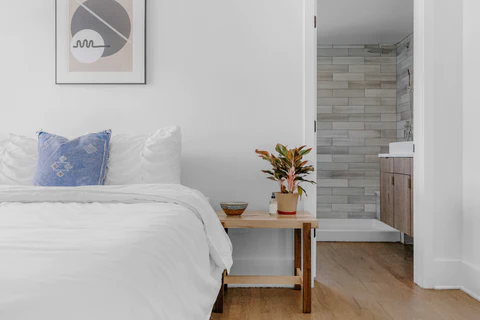Allergy-Proofing Your Bedroom
If Your Allergies Always Act Up At Home, Your Bedroom Is Most Likely To Blame.
If your allergies always act up at home, or you frequently wake up sniffling, sneezing, or dealing with nasal stuffiness, your bedroom is most likely to blame. It’s chock-full of the most common indoor allergens, from mold and dander to the collection of dust mites on your bedsheets. Since these dust mites (actually, their excrement) love beds that provide warmth, humidity, and food (i.e., our dead skin cells), our sleeping sanctuary is also theirs.
Properly preparing your bed can help alleviate those pesky sneezing bouts and allow for more restful, uninterrupted sleep during the hours you spend there. Here are 10 simple steps you can take to make your bedroom a hypoallergenic haven.
1. Deep Clean Your Sheets
Allergens live in the folds and creases of your sheets, so deep cleaning your bedding often is your first line of defense. Washing your bedding at least weekly in water that is at least 130°F and using a hot drying cycle is recommended. This is the most effective way to remove dirt, sweat, skin cells, oil buildup, and dust mites from your sheets.

2. Only Use Hypoallergenic Bedding
Speaking of sheets, switching to hypoallergenic bedding can significantly relieve your symptoms by preventing dust mites from reproducing. Materials like organic cotton, wool, bamboo, and microfiber are made of moisture-wicking, antimicrobial materials that are naturally resistant to dust mites and mildew. The higher thread count the better, since a tight-weave structure eliminates gaps where allergens like to thrive. Most allergists agree the best hypoallergenic fabric is silk, which not only fights off allergens but also soothes sensitive skin. (Silkworms actually produce a protein that makes silk resistant to germs, dust mites, and other allergens.) Although it’s a bit of an investment, its allergy-proof qualities could be worth the splurge.
Sleep on a pure, organic natural latex mattress. Latex mattresses are hypoallergenic and prevent allergy affecting microorganisms such as fungus, bacteria, and dust mites from invading the mattress.
3. Don’t Make Your Bed Right Away
Take this tip with a grain of salt, but studies have indicated that an unmade bed is better for allergy sufferers. That’s because dust mites thrive in the humid, warm conditions of a neatly made bed, but dry out when the blankets are left thrown off. Something as simple as leaving a bed unmade during the morning can allow moisture to escape from the sheets and mattress so the mites will dehydrate and eventually die. This isn’t to say not making your bed will totally eliminate dust mites, but it is a solid excuse for the lazy among us.
4. Apply Dust-Proof Covers
To go the extra mile, apply tightly woven covers with zippered encasements on pillows, mattresses, box springs, and other items unable or unlikely to be washed. This will keep dust mites out and prevent them from multiplying on your bed.
Think of your pajamas as another cover (for your shedding skin), so it’s best to change into freshly laundered jammies every night.
5. Take A Shower Before Bed
After being outdoors, it’s essential you rinse off, so you’re not dragging in pollen or other allergens into your bedroom and bed with you. If your hair is wet after your shower, dry it first with a blow-dryer before going to bed to keep moisture from leading to mold growth on your pillow. Move your shower to an earlier time if you like to air-dry your hair.
6. Run An Air Purifier
The right air filter or circulation system can be a great ally in your fight against allergies. You can either add these directly to your furnace or set up a room unit; look for an air-filtration system that uses a small-particle or HEPA filter, which will help to scrub dust, pollen, and mold spores from the air.
7. Declutter Your Space
If something traps dust, it will draw dust mites. Try to get rid of anything in your bedroom that can easily collect dust—the less upholstery in the room, the better. This includes stuffed animals, excessive throw pillows, and non-leather chairs. Books collect lots of dust too, so move them to a different room when you’re not reading them.

8. Keep Pets Out Of Your Bedroom
Dogs and cats may provide you with unconditional love, but they also trigger allergies. They have dead skin cells that can become airborne, settling into dust, and triggering symptoms of allergies. If you suspect your pet could be triggering your allergies, have an allergy test to figure out your sensitivities. Keep your pets out of your bedroom, so you can eliminate allergies causes by pet dander.
9. Vacuum Regularly
Got carpet? Consider replacing it with hardwood floors if possible. It’s also a good idea to remove any area rugs since they tend to collect a lot of dust. If you can’t help having carpet in your bedroom, vacuum with a double micro-filter bag or HEPA filter every other day. Wear a face mask while you vacuum so you don’t inhale allergens, and limit your vacuuming to the daytime so the dust has time to settle before you go to sleep.
10. Close Your Windows
It might tempt you to crack the windows in your bedroom during warmer weather, but when you do this, it allows pollen to come into your bedroom, and settle in your carpet or other spots. To avoid an allergic reaction, keep the windows closed.
These are only some ways to allergy-proof your bedroom. The more you can do to keep pollen, dust, mites, and pet dander out of your bedroom, the better you’ll feel, and the better you’ll sleep.
